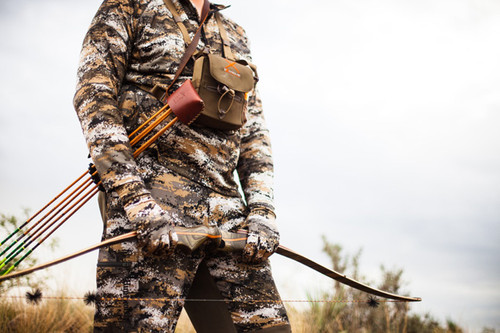From Compound to Traditional
Published on Nov 18th 2021 by Brian Strickland
I’ve always been infatuated with traditional bowhunting. From the moment I picked up my first compound bow and slipped an arrow through the ribs of my first bull elk, I’d often wondered if I was on my designed bowhunting path. However, when I released an arrow with a traditional bow for the first time several years ago, I knew in an instant the bowhunting path I was meant to be on. Don’t misunderstand me, I have enjoyed every adventure I have had with my compound bow for the last two decades, but there is something truly special about the simplicity and raw beauty of a traditional bow.
I will readily admit, there has been a steep learning curve the past couple of years. Not only did shot distances shrink considerably, but accuracy also suffered when compared to the compound. Along with this comes the mental side of making the switch. You will not only experience more misses and have to turn down shot opportunities that you could have easily made with a compound, but you may have to lower your expectations on the quality of game you’re after if you expect to fill the freezer. That being said, it was the challenge that guided me to bowhunting in the first place, and the traditional bow is the perfect fit for anyone looking for the ultimate challenge.
Once you decide to pick up the challenge, there are certain elements you should embrace if you expect to find success. First and foremost, start off with a light-weight bow. When I switched, the draw weight on my compound was about 70 pounds and my current traditional bow is around 50 pounds. Starting off with a heavy-weight traditional bow compromises form, creates an inconsistent anchor point and you will struggle with accuracy. Ideally, you should be able to slowly draw the bow back to anchor and be able to hold it for several seconds before releasing an arrow. For most people, the best learning weight will be in the 45-pound range.
As far as draw weight when hunting is concerned, with modern bow design and construction, modern strings, faster carbon arrows and razor-sharp broadheads, today’s 40- to 50-pound traditional bows will blow through medium sized game like deer, black bears and pigs with relative ease. With today’s takedown traditional bows you can always get heavier limbs once you increase your stamina and are feeling the need to test your new found challenge on bigger game such as elk, moose and perhaps grizzly bears if you’re up for heart-pounding encounters.
Regardless of whether you choose to shoot a longbow or recurve, or your shooting style encompasses the GAP or Instinctive methods, being a successful traditional bowhunter really boils down to a lot of practice. For me personally, this means slinging at least two to three dozen arrows every day when possible. Shooting more than this generally causes my accuracy to suffer as I get tired; however, this small window of just 20 to 30 arrows allows me to really create a consistent platform. Ideally I want to consistently hit a 6” pie plate out to 30-35 yards. For the whitetail hunter, distances are obviously much shorter, but it’s really not the distance as much as it’s the consistent accuracy you’re looking for. If you can consistently hit the kill zone at 30 and 40 yards, then those 20 yard whitetail shots will come with ease.
During a hunt I also like to stump shoot with blunt tips when given the opportunity. Not only does this instill confidence, but it also helps me become more consistent at judging distances on the fly. Confidence plays a huge role when it comes to success with a traditional bow, and having confidence allows you to trust your instincts so you can deliver a lethal shot.
Also, one of the biggest mistakes I made when starting out was failing to “pick a spot” when it was time to let the string slip from my fingers. I tended to concentrate on the whole animal instead of zeroing in on the sweet spot. Needless to say, it cost me a few misses and even a wounded Idaho black bear. Picking a spot seems simple enough but in the moment of truth I failed to concentrate where needed. This is a skill that will be developed over time with lots of practice, but once conquered, you will see your groups tighten and confidence soar.
Lastly, traditional bowhunting is tough, especially for beginners. However, there are a ton of online resources that you can gleam knowledge from to get you through the tough spots. Also, finding a local resource can be very helpful. You’d be surprised just how many traditional bowhunters are likely living near you who are more than willing to take someone under their wing.